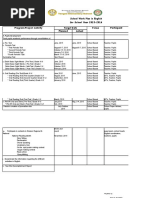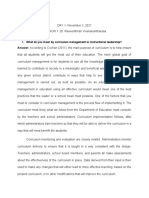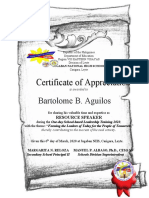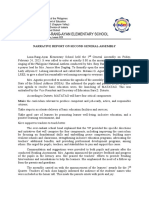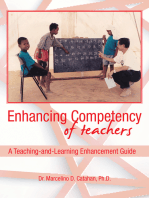100%(4)100% found this document useful (4 votes)
4K viewsRemedial & Enrichment Activities
Remedial & Enrichment Activities
Uploaded by
yna_princess cancerRemedial and enrichment activities aim to help learners overcome gaps and errors in their English, notice their mistakes, and discover what is correct on their own. They also seek to reactivate and clarify previously taught language and monitor learner errors and problems to address both general issues and individual challenges.
Copyright:
Attribution Non-Commercial (BY-NC)
Available Formats
Download as PPTX, PDF, TXT or read online from Scribd
Remedial & Enrichment Activities
Remedial & Enrichment Activities
Uploaded by
yna_princess cancer100%(4)100% found this document useful (4 votes)
4K views4 pagesRemedial and enrichment activities aim to help learners overcome gaps and errors in their English, notice their mistakes, and discover what is correct on their own. They also seek to reactivate and clarify previously taught language and monitor learner errors and problems to address both general issues and individual challenges.
Copyright
© Attribution Non-Commercial (BY-NC)
Available Formats
PPTX, PDF, TXT or read online from Scribd
Share this document
Did you find this document useful?
Is this content inappropriate?
Remedial and enrichment activities aim to help learners overcome gaps and errors in their English, notice their mistakes, and discover what is correct on their own. They also seek to reactivate and clarify previously taught language and monitor learner errors and problems to address both general issues and individual challenges.
Copyright:
Attribution Non-Commercial (BY-NC)
Available Formats
Download as PPTX, PDF, TXT or read online from Scribd
Download as pptx, pdf, or txt
100%(4)100% found this document useful (4 votes)
4K views4 pagesRemedial & Enrichment Activities
Remedial & Enrichment Activities
Uploaded by
yna_princess cancerRemedial and enrichment activities aim to help learners overcome gaps and errors in their English, notice their mistakes, and discover what is correct on their own. They also seek to reactivate and clarify previously taught language and monitor learner errors and problems to address both general issues and individual challenges.
Copyright:
Attribution Non-Commercial (BY-NC)
Available Formats
Download as PPTX, PDF, TXT or read online from Scribd
Download as pptx, pdf, or txt
You are on page 1of 4
REMEDIAL & ENRICHMENT
ACTIVITIES
Purpose for Remedial & Enrichment
Activities
Purpose for Remedial & Enrichment
Activities
To help learners overcome gaps & errors in their English,
especially fossilized errors
To make learners notice their mistakes or errors and discover for
themselves what is wrong and right.
To reactivate, consolidate and clarify previously presented
language items.
To monitor leaner's errors, mistakes or slips.
To distinguish between general problems and those of
individual learners.
References
Paul Davies. (2000). Success in
English Teaching. New York; Oxford
University Press.
Nesamalar, Saratha, The Soo Choon.
(1995). ELT Methodology Principles
and Practice. Selangor; Penerbit
Fajar Bakti Sdn. Bhd.
You might also like
- Rationale Statement Lesson PlanDocument2 pagesRationale Statement Lesson Planapi-315588651No ratings yet
- Philosophy of EduDocument4 pagesPhilosophy of Eduapi-311846079100% (1)
- Madeline Hunter Lesson CycleDocument1 pageMadeline Hunter Lesson Cycleapi-326092486100% (1)
- Remedial & EnrichmentDocument22 pagesRemedial & EnrichmentIbrahim AbuNo ratings yet
- Brigada Eskwela Action PlanDocument3 pagesBrigada Eskwela Action PlanEdgar Senense CariagaNo ratings yet
- Synthesis InsetDocument1 pageSynthesis InsetAnj Rivera100% (1)
- Modular Teaching PDFDocument3 pagesModular Teaching PDFKazumi GraceAnnNo ratings yet
- Localization and ContextualizationDocument20 pagesLocalization and ContextualizationGendolf NiepesNo ratings yet
- Criteria For CurriculumAssessment - REPORTDocument41 pagesCriteria For CurriculumAssessment - REPORTLeoncio LumabanNo ratings yet
- Basic Education Research AgendaDocument26 pagesBasic Education Research AgendaMejoy Marbida0% (1)
- School Work Plan in English For School Year 2015-2016 Program/Project/ Activity Target Date Venue Participant Planned ActualDocument6 pagesSchool Work Plan in English For School Year 2015-2016 Program/Project/ Activity Target Date Venue Participant Planned ActualAngela Fatima Quilloy-MacaseroNo ratings yet
- Basic Concepts - Formativa and Summative EvaluationDocument21 pagesBasic Concepts - Formativa and Summative EvaluationHarold John100% (1)
- Contextualization and Location NTOT AP G10Document30 pagesContextualization and Location NTOT AP G10Adrian Astro de Vera100% (4)
- Aitsl Powerpoint Effective FeedbackDocument24 pagesAitsl Powerpoint Effective Feedbackace hawkNo ratings yet
- PILONGO, Romeo A.: QuestionsDocument2 pagesPILONGO, Romeo A.: Questionsromeo pilongo100% (1)
- 03 Policy Guidelines K To 12 AssessmentDocument94 pages03 Policy Guidelines K To 12 AssessmentHenry Kahal Orio Jr.No ratings yet
- Teacher: Education CouncilDocument33 pagesTeacher: Education CouncilVincent LibreaNo ratings yet
- Project ProposalDocument3 pagesProject ProposalPaulojoy BuenaobraNo ratings yet
- MCT Lesson Observation Report - Layla Ahmed - Visit 1 - Semester 1Document2 pagesMCT Lesson Observation Report - Layla Ahmed - Visit 1 - Semester 1api-242964397No ratings yet
- Increasing Awareness On Climate Change of Grade 6 Pupils in Bulan North Central School B Bulan III District Using Present Engage Build Infographic Utilization TechniqueDocument32 pagesIncreasing Awareness On Climate Change of Grade 6 Pupils in Bulan North Central School B Bulan III District Using Present Engage Build Infographic Utilization TechniqueAbel Gayafranca GutlayNo ratings yet
- Classroom Management PlanDocument5 pagesClassroom Management Planapi-245312762No ratings yet
- Meaning o F CurriculumDocument3 pagesMeaning o F Curriculumcherry adolfoNo ratings yet
- Educational Planning and DevelopmentDocument7 pagesEducational Planning and DevelopmentJessica Ilene Capinig100% (2)
- Table of Contents - RpmsDocument3 pagesTable of Contents - RpmsShyr R PalmNo ratings yet
- Output: Learning Plan: LDM1 COURSE MODULE 1 - Course Introduction/Getting StartedDocument22 pagesOutput: Learning Plan: LDM1 COURSE MODULE 1 - Course Introduction/Getting StartedPamela Villahermosa92% (13)
- Using DOD To Validate Evidence of SBM PracticeDocument20 pagesUsing DOD To Validate Evidence of SBM PracticeLeoncio Lumaban80% (5)
- 03 Faq About ObeDocument4 pages03 Faq About ObeZainalNo ratings yet
- Guidance Program Sy 2022-2023Document2 pagesGuidance Program Sy 2022-2023Lorena RomeroNo ratings yet
- Certificate of Appreciation: Bartolome B. AguilosDocument1 pageCertificate of Appreciation: Bartolome B. AguilosMARIAN TIMTIMANNo ratings yet
- Session 1 Learning Resource Materials Sir CapusiDocument60 pagesSession 1 Learning Resource Materials Sir CapusiMarife Abbang Ferrer100% (2)
- Thesis Proposal SampleDocument9 pagesThesis Proposal SampleDerrick Buot Zerep100% (3)
- RPMS Phase 2 - Coaching RevisedDocument29 pagesRPMS Phase 2 - Coaching RevisedJohn Walter Torre100% (1)
- Principle 2: Curriculum and Instruction Indicators 1 2 3Document5 pagesPrinciple 2: Curriculum and Instruction Indicators 1 2 3ruel gervacioNo ratings yet
- LDM Practicum Portfolio EditableDocument21 pagesLDM Practicum Portfolio EditableJane Ilagan Vizco95% (55)
- Narrative - 2nd General AssemblyDocument2 pagesNarrative - 2nd General AssemblyMarianne Uy100% (1)
- Session-Guide-MULTIPLE Test-Construction-revisedDocument7 pagesSession-Guide-MULTIPLE Test-Construction-revisedAzy NethNo ratings yet
- The Nature of ReadingDocument29 pagesThe Nature of ReadingMary Joy Robis100% (1)
- List of Needed Documents For SBM PrinciplesDocument22 pagesList of Needed Documents For SBM PrinciplesLuisa SamianoNo ratings yet
- Specific Practices and Documents Needed To Support Diff. Principles For ValidationDocument21 pagesSpecific Practices and Documents Needed To Support Diff. Principles For ValidationArnoldBaladjayNo ratings yet
- Action Research Topics in English Grade 4Document3 pagesAction Research Topics in English Grade 4Aicy ManliguezNo ratings yet
- LacDocument23 pagesLacJonathan ArayaNo ratings yet
- Accomplishment ReportDocument2 pagesAccomplishment ReportJake Bryson DancelNo ratings yet
- Gate Lesson PlanDocument2 pagesGate Lesson Planapi-396424398No ratings yet
- School Plan For Professional Development (SPPD)Document1 pageSchool Plan For Professional Development (SPPD)Yuini KarpyoNo ratings yet
- RPMS Portfolio 2019Document32 pagesRPMS Portfolio 2019Cristina MerniloNo ratings yet
- Educational PsychologyDocument3 pagesEducational Psychologygul_e_sabaNo ratings yet
- Enhancing Instructional Leadership For Filipino Teachers in Senior High School: A Case Study in The School Division of ManilaDocument6 pagesEnhancing Instructional Leadership For Filipino Teachers in Senior High School: A Case Study in The School Division of ManilaPsychology and Education: A Multidisciplinary Journal100% (1)
- Accomplishment Report 2016-2017Document4 pagesAccomplishment Report 2016-2017Anjo Gianan Tugay100% (1)
- Dick and Carey ModelDocument29 pagesDick and Carey Modelvanessa yganaNo ratings yet
- PMCF SampleDocument1 pagePMCF SampleJeanette MartinNo ratings yet
- TRFDocument4 pagesTRFMitchell Cam100% (1)
- Learning Delivery Modalities Course 2: Reflection BDocument3 pagesLearning Delivery Modalities Course 2: Reflection BJowhcelhyn83% (30)
- Administrative Functions of The Bureaus of Elementary Education, Secondary Education and Higher EducationDocument14 pagesAdministrative Functions of The Bureaus of Elementary Education, Secondary Education and Higher EducationMarianer MarcosNo ratings yet
- Progressive Education In Nepal: The Community Is the CurriculumFrom EverandProgressive Education In Nepal: The Community Is the CurriculumNo ratings yet
- Enhancing Competency of Teachers: A Teaching-And-Learning Enhancement GuideFrom EverandEnhancing Competency of Teachers: A Teaching-And-Learning Enhancement GuideNo ratings yet
- Syllabus-Jrn 223 Campus JournalismDocument9 pagesSyllabus-Jrn 223 Campus JournalismMae Sheilou Conserva Patero100% (1)
- Statement of The ProblemDocument3 pagesStatement of The ProblemCasey HachilesNo ratings yet
- Present Tense (Sekarang) Past Tense (Dah Lepas)Document1 pagePresent Tense (Sekarang) Past Tense (Dah Lepas)yna_princess cancerNo ratings yet
- Headcount Upsr 2017 SK Bikam, 35600 Sungkai, PerakDocument20 pagesHeadcount Upsr 2017 SK Bikam, 35600 Sungkai, Perakyna_princess cancerNo ratings yet
- Lattice LagiDocument6 pagesLattice Lagiyna_princess cancerNo ratings yet
- Lattice: By: Nur Alina Syuhada BT Abd RahimDocument4 pagesLattice: By: Nur Alina Syuhada BT Abd Rahimyna_princess cancerNo ratings yet










